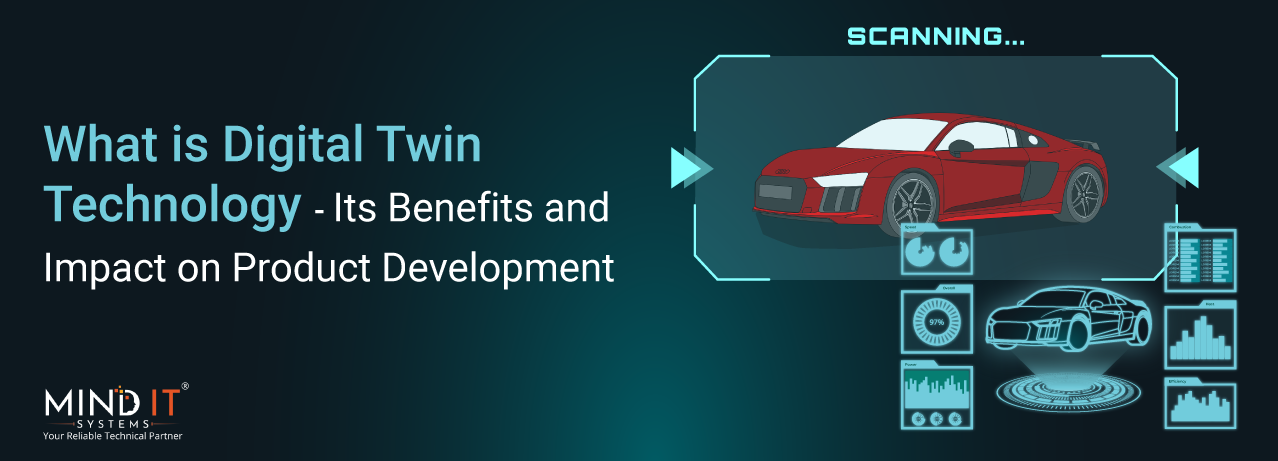
What is digital twin technology – Its Benefits and Impact on Product Development
Digital twin technology is rapidly transforming the way companies approach product development. By creating virtual replicas of physical objects, businesses can monitor and analyze real-time performance, optimize design and manufacturing processes, and reduce costs. Based on the report by Fortune Business Insights, the digital twin market is expected to grow at a compound annual rate of 42.6% and reach a value of $USD 137.67 billion by 2030.
The tables below show the scope of digital twin technology.
Scope of Digital Twin Technology
| ATTRIBUTE | DETAILS |
|---|---|
| Study Period | 2019-2030 |
| Base Year | 2022 |
| Estimated Year | 2023 |
| Forecast Period | 2023-2030 |
| Historical Period | 2019-2021 |
| Growth Rate | CAGR of 42.6% from 2023 to 2030 |
| Unit | Value (USD Billion) |
| Segmentation | By Type, By Application, End-user, and Geography |
| By Type |
|
| By Application |
|
| By End-User |
|
Image Source: Fortune Business Insights
From optimizing design and manufacturing to improving product quality and reducing time to market, digital twins can help companies achieve their goals and stay ahead of the competition. To reveal more information on what digital twin technology is, its benefits for businesses, and its impact on product development, read this blog post.
What is digital twin technology (DTT)?
Digital twin technology is a virtual model of a physical object, process, or system used to simulate, analyze, and optimize performance. It is a powerful tool that has gained popularity recently, particularly in the manufacturing, healthcare, and energy sectors.
One of the key benefits of DTT is that it allows for better decision-making and problem-solving. By creating a virtual dummy of a physical asset or system, engineers can test and optimize various scenarios without disrupting the existing system. It helps reduce risk and cost and improves efficiency and performance. In addition, this enables real-time monitoring and analysis of systems, which helps identify issues and opportunities for improvement.
DTT (digital twin technology) is an innovative tool to transform industries and drive economic growth. As more businesses recognize its benefits, we expect it to see continued growth in near future.
Digital Twin Definition
A digital twin is a complete and accurate replica of a physical system or asset. It is created by integrating sensor data, machine learning algorithms, and other advanced technologies to simulate the behavior and performance of the physical asset or system.
Dr. Michael Grieves, the founder, and chairman of Interactive Frontiers, Inc., coined the term “digital twin” to define a virtual representation of a physical product or process that businesses can utilize to comprehend and anticipate the performance characteristics of its physical counterpart.
The ability to provide real-time data and analytics makes digital twin technology the key player for businesses and organizations looking to stay competitive and improve their bottom line.
What are the different kinds of Digital Twins?
Some of the most common types of digital twins include:
- Product digital twins: These are virtual replicas of physical products, such as cars, airplanes, or consumer electronics. It aids in detecting inefficiencies, streamlining procedures, and enhancing quality assurance.
- Process digital twins: The process digital twins refer to virtual replicas of manufacturing processes, supply chains, or other operational workflows. It helps to identify incapabilities, optimize workflows, and improve quality control.
- Performance digital twins: These are virtual representations of physical assets, such as turbines, engines, or buildings. Performance digital twins can monitor and analyze real-time data, predict maintenance needs, and optimize performance.
- System digital twins: These are virtual copies of complex systems, such as smart cities, transportation networks, or power grids. System digital twins can monitor and optimize performance, predict failures and outages, and improve sustainability.
- Human digital twins: They are virtual models of real individual humans created using data from wearable devices, health records, and other sources. It enables personalized analysis, prediction, and decision-making in healthcare, education, and other fields.
Whether designing products, optimizing processes, or managing complex systems, digital twins can help you make better decisions, reduce risk, and improve performance.
How do digital twins operate?
Here’s a breakdown of how digital twins operate:
- Sensors collect data: Digital twins rely on sensors to collect data from the physical asset or system. These sensors can monitor everything from temperature to vibration and more.
- The model receives input data: The model ingests sensor data to generate a virtual representation of the physical system or asset.
- Machine learning algorithms analyze data: The performance of the system or physical asset is analyzed and predicted using machine learning algorithms.
- Real-time analytics: With the virtual replica, engineers can use real-time analytics to test and optimize various scenarios without disrupting the system.
Marc Andreessen (Venture Capital Investor & Software Engineer) stated, “The digital twin concept is a real thing that works today, and it is driving incredible value for companies that have adopted it.”
Benefits of Digital Twins
Digital twin technology offers several advantages for businesses and organizations, including:
- Predictive Maintenance: Digital twins can enable predictive maintenance that anticipates maintenance requirements and identifies potential issues before they cause any downtime or other problems.
- Improved Efficiency: Businesses can identify opportunities to optimize processes and improve efficiency by analyzing data from the digital twin.
- Reduced Risk and Costs: Digital twins can test and optimize various scenarios without disrupting the system, reducing risk and costs.
- Enhanced Product Development: Before a product hits the market, Digital Twins efficiently evaluates and improves it. It cuts down on the time and expense of physical prototyping.
The values and advantages of digital twin technology are vast, and as more businesses adopt this technology, it can revolutionize businesses and bring significant benefits in terms of cost savings, efficiency, and innovation.
Which Product Life Cycle Stage Can Owe the Most Value?
Following are some insights into which product life cycle stage can owe the most value from digital twins:
Development Stage:
During the development stage, businesses can use digital twins to simulate and test products. This method makes identifying and addressing potential issues easier before they escalate into problems. Additionally, it can significantly decrease the time and expenses associated with physical prototyping and testing.
Manufacturing Stage:
Using digital twins can enhance manufacturing processes, minimize waste, and boost efficiency. As a result, businesses can save money and boost productivity.
Operational Stage:
Employing digital twins can aid in monitoring performance and forecasting maintenance requirements, resulting in less downtime and increased efficiency. Implementing this approach can lead to significant cost savings and improved profit margins.
To get a better overview of how it can help various sectors we have the table below:
Digital Twin Applications in Various Sectors
| Manufacturing | Healthcare | Supply Chain |
|---|---|---|
| Implementing digital twins can allow businesses to design different permutations of the product that can help them render personalized products and services to customers. | Pharma companies utilizing digital twins can build genomes of patients’ physical characteristics and lifestyles. It can help them to improve personalized care. | Logistics companies can determine the packaging conditions that can delay product delivery. |
| Engineers can test the feasibility of the products before deploying their product. | Allows hospital operational strategies and care models to build, thus enhancing the operational efficiency of healthcare organizations. | Additionally, logistics companies can test warehouse layouts to improve operational efficiencies. |
Potential Limitations and Challenges of DTT
While digital twin technology offers many benefits, it also poses some limitations and challenges that decision-makers must be aware of. Here are some insights into DTT’s weaknesses and challenges:
- Data Security: Digital twins rely on data, which can be vulnerable to cyber threats. Ensuring data security and privacy is essential to prevent data breaches.
- High Initial Investment: Implementing digital twin technology can be costly, especially for small businesses. The cost of equipment, software, and personnel can be a significant barrier to entry.
- Data Integration: Combining data from different sources can be challenging, especially if the data is in different formats or stored in different systems.
Only 19% of companies have implemented digital twin technology (Gartner survey report shared with CGT.)
It’s important to consider the potential challenges and limitations. Addressing these challenges through careful planning and implementation can help businesses overcome barriers and leverage the full potential of digital twin technology.
What are the steps to begin and thrive in a digital twin venture?
Embarking on a digital twin venture can be challenging for businesses but it is certainly a rewarding process. Here are some essential steps you need to consider for a digital twin venture:
- Identify the correct use case: Determine the area of your business where digital twin technology can add the most value.
- Develop a strategy: Create a roadmap for implementing digital twin technology (DTT), including a plan for data collection, analysis, and visualization.
- Choose the right technology: Use the tools and platforms to support your digital twin initiative.
- Invest in expertise: Hire personnel with expertise in DTT to ensure successful implementation.
Investing in technology and prioritizing innovation is critical to thriving in a digital twin venture. Implementing DT (digital twin) technology in software product development can revolutionize how businesses operate, enabling them to simulate and evaluate products before their physical construction, thereby decreasing development time and expenses.
Wrapping Up
The potential impact of digital twin technology on product development is substantial. As technology advances and gains wider acceptance, businesses across industries can likely experience significant improvements in their operations and bottom line. In today’s rapidly changing business environment, companies can acquire a competitive edge and stay ahead of the curve by utilizing DT technology.
Feel free to contact us for any queries, support, or consultation!
Share this post
About the Author

Sujoy Roy
(Head – Digital Marketing)
From my teenage time, I had a quench to solve problems and loved leadership. Starting my career in relation management, ignited my passion for managing people. While managing I realized technology needs to be incorporated to keep pace with the changing world & do my work efficiently.

